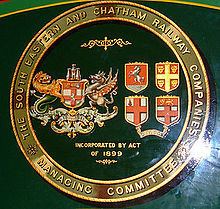Founded 1 January 1899 | ||
 | ||
The South Eastern and Chatham Railway Companies Joint Management Committee (SE&CRCJMC), known as the South Eastern and Chatham Railway (SE&CR), was a working union of two neighbouring rival railways, the South Eastern Railway (SER) and London, Chatham and Dover Railway (LC&DR), which operated between London and south-east England. Between 1899 and 1923, the SE&CR had a monopoly of railway services in Kent and to the main Channel ports for ferries to France and Belgium.
Contents
- Formation
- Integration
- Further development
- Accidents and incidents
- SECR locomotives
- Electrification
- Ships
- References
The companies had competed extensively, with some of the bitterest conflicts between British railway companies. Competing routes to the same destinations were built, so many towns in Kent were served by both companies, with a legacy of two stations and services to multiple London termini.
Formation
By the end of the 19th century, the SER and LC&DR had fought over a small and not particularly lucrative territory for 40 years. Both were notorious for the poor punctuality of their services and the decrepitude of their rolling stock, and the struggles had driven both companies to the verge of bankruptcy. It became inevitable that they must combine or succumb.
The SE&CR was formed on 1 January 1899, when the SER and LC&DR formed a "management committee" comprising the directors of both companies. This merged the two companies' operations, although they remained legally separate, with receipts split 59% to SER and 41% LC&DR until the Grouping, to avoid the costs and risks of a formal merger.
Integration
The SE&CR began connecting the two networks and new services were introduced, reaping the benefits of joint working. A significant step was the construction of a junction in 1902-4 between the SER and LC&DR main lines where they crossed near Bickley and St Mary Cray, east of Bromley; the LC&DR's line via Maidstone to Ashford was connected to the SER station at Ashford; and the SER branch from Strood to Chatham alongside the LC&DR's main line to Chatham was closed prior to World War I. The overlapping networks on the Isle of Thanet (Margate-Broadstairs-Ramsgate) were rationalised by the Southern Railway. Service cuts under BR saw Gravesend lose its second station.
Further development
After the formation of the SE&CR, three minor lines were built before the formation of the Southern Railway in 1923. They were:
Accidents and incidents
SE&CR locomotives
The LC&DR's works at Longhedge, Battersea closed in 1911 and production was concentrated at Ashford. Harry Wainwright was replaced by Richard Maunsell as Locomotive Superintendent in 1913.
Electrification
With the development and implementation of electrification by the L&SWR, the LB&SCR, the "Tube" companies and tram operators in the early twentieth century, the SECR planned to start electrifying its lines. The proposed method was 1500V DC using two additional rails - i.e. four rails like London Underground and the L&NWR. This very high voltage for rail track level systems was used in Britain only on the L&YR's 1200V DC side-contact third-rail line from Manchester Victoria to Bury. Grouping in 1923 led to Southern Railway's adopting the L&SWR's standard of 660V DC third rail on the SECR's network.
Ships
The SE&CR operated ships on cross-channel services.
